Although we are calling this an entry level camera, this is a very good underwater camera. It's also a good option for snorkeling because it's waterproof without a housing down to 50 feet (15 meters).
The TG-6 has a high speed 12 MP sensor designed for excellent low light performance and noise reduction. It shoots 4k video, RAW photos, and includes built in WIFI, making transferring photos on the go easy. It's important to note that there is no full manual control on this camera. For the casual photographer who doesn't want to have to think about their camera settings this is probably not an issue. But if you want more control, you may want to consider a different camera. you'll be happier with an of the other cameras we mentioned above. For the housing, we recommend either the Olympus housing or the premium Isotta housing.
Pros
- Smaller size for travel
- Ability to change wet lenses underwater
- Much less cost
Cons
- Smaller sensor means less detail and more noise at high ISO
- Shutter delay and focus delay is slow
- Less control over depth of field.
High-End Level Compact Camera – Sony RX100 VII
Key Features:
1-inch 20.1 MP stacked CMOS sensor
BIONZ X processor
Built-in 24-200mm (equivalent) f/2.8-4.5 zoom lens
Electronic shutter up to 1/32000s
4K video with full pixel readout
S-LOG2, S-Log3, and HLG picture profiles
Pop-up EVF (2.36 million dots)
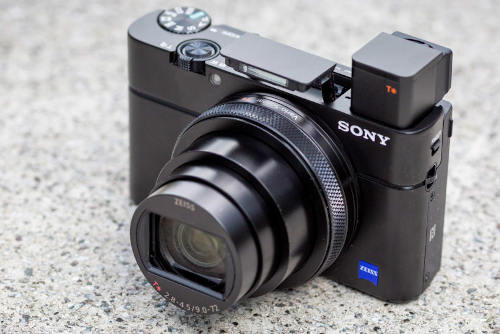
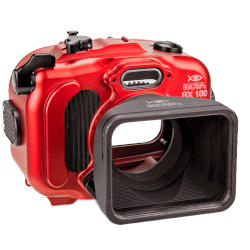
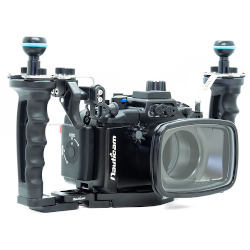
The Sony RX100 VII is packed with great features and improvements from its predecessor. New technologies have been integrated into the camera, which is similar to its cousins, the A9 and A6400. The improved autofocus tracking system, including animal eye autofocus makes the Sony RX100 VII a top choice for underwater photographers. You won’t find more useful technology for photographing underwater creatures on any other compact camera. Other upgrades include burst shooting without blackout and improved low light capability with a lower native ISO.
There are three things that make the RX100 series one of the best underwater compact camera series. First, the 1-inch sensor size is larger than most other compact cameras. The larger sensor produces better image quality and better low-light performance due to a larger pixel size. Second, the auto-focus speed is faster than traditional compact cameras. Thirdly, the advanced 4K video features available in the RX100 series are the top-of-the-line when it comes to compact camera video systems.
The highlight of this camera is its unprecedented macro capability. The zoom on the 24-200 mm f/2.8-4.5 zoom lens cannot be beaten by other compact underwater setups. Details captured with this lens are remarkable. When combined with a wet macro lens, the realm of super macro photography is attainable. The tiniest details of the smallest subjects can be captured with this set up. For the housing, we recommend either the Nauticam housing or the premium Isotta housing.
Pros
- Sharp 8x zoom lens
- Electronic viewfinder
- 1-inch sensor design
- Eye detection
Cons
- Expensive
- Can't start video while images are writing to card
- Limited touch functions
Mirrorless Camera – Panasonic GH5
Key features:
20MP Four Thirds sensor
5-axis in-body image stabilization system
4K footage taken using full width of sensor
Internal 4K/30p 10-bit 4:2:2 video capture
1080 video at up to 180p, enabling 7.5x slow-motion
4K and 6K Photo
9 fps shooting with continuous autofocus
Dual UHS II card slots
5GHz Wi-Fi, NFC and Bluetooth
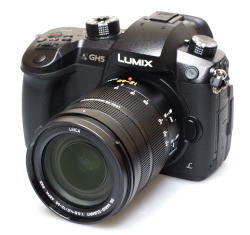
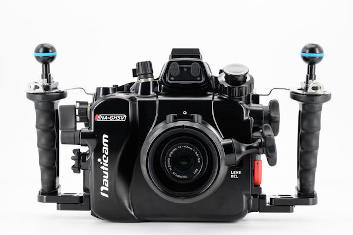
The Panasonic Lumix DC-GH5 is the fifth in the company's industry-changing video and stills 'hybrid' lineup. With its 20MP Four Thirds sensor and deep video-centric feature set, it looks likely to pick up where the GH4 left off as a favorite of indie filmmakers and photographers whose interests venture into the realm of motion picture work.
The camera offers carefully thought-out features designed to let videographers of all levels record what they need with the new system. The body is larger and the price tag increased as a result, but the video produced speaks for itself. And the GH5's still photo capability holds its own against the best from Olympus and Sony.
The benefit of mirrorless cameras is that they offer the flexibility of interchangeable lenses, with a higher quality and better focusing than compacts in a smaller, lighter package than their DSLR counterparts. As the mirrorless cameras are becoming more robust, we’ve seen the sizes of these cameras begin to increase, getting close in size as DSLR cameras. We’re not quite there yet, and the Panasonic GH5, which the largest of the mirrorless options so far, is still smaller than a DSLR.
GH5 underwater housings are smaller than DSLR housings, and support both the GH5 and GH5s cameras, in addition to a variety of micro-four thirds lenses. The Panasonic 12-35mm lens is a popular choice for underwater video. For the housing, we recommend the Nauticam housing as it supports the largest number of lenses.
Pros
- 20MP sensor gives increase in resolution without increase in noise
- Highly impressive video specifications (4:2:2 10-bit color, 4K/60p)
- Auto ISO added for manual movie shooting
- JPEG color improved
- Dual UHS-II card slots, support for faster V60 cards in the future
- Settings can be saved to card
- Good battery life
Cons
- On the larger end of the Micro Four Thirds cameras
- JPEG sharpening improved
- Viewfinder resolution drops noticeably during high-speed bursts
- Autofocus in video can exhibit focus hunting
- Slight decrease in video quality when shooting high frame rates (180fps)
Full Frame Mirrorless Camera – Nikon Z6 / Z7
Z6 Key features:
24.5MP sensor
5-axis image stabilization system
1080 video at up to 120 fps
4K video at up to 24 fps
12 fps burst shooting
ISO 100-51200
273-point hybrid phase-detection autofocus
Z7 Key features:
45.7MP sensor
5-axis image stabilization system
1080 video at up to 120 fps
4K video at up to 24 fps
9 fps burst shooting
ISO 64-25600
493-point hybrid phase-detection autofocus
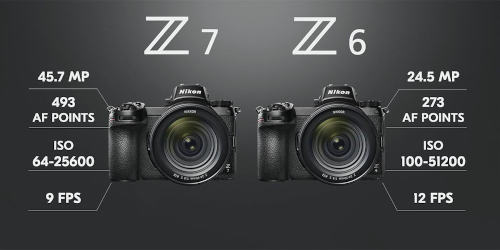
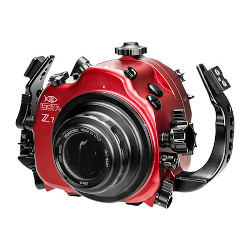
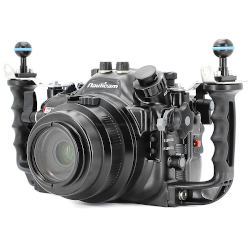
The most important distinctions between the Z6 and Z7 are the sensor resolution and autofocus - both are markedly better on the Z7. Additionally, the Z7 has a native ISO of 64, expandable down to 32, which is better than the Z6's native ISO of 100 (expandable down to 50). This means the Z7 will pull out more details from the shadows and highlights than the Z6. Other than that, the cameras are almost the same, including the same physical dimensions and weights. And of course, the cost, with the Z7 about $1200 higher in price.
The most enticing thing about the Z6 and Z7 is the excellent construction. The weather sealing is tough in variable weather conditions. The Z7 is much smaller and lighter than the D850 (675g vs 1005g). For the travelling diver, the Z6 or Z7 wins every time.
The image quality on the Z7 is amazing. At first you might think that 45.7 MP is more than enough pixels in one camera. However, every bit of that information is useful. When you have so many megapixels on a full-frame sensor, you’re left with an ability to crop photos and produce a large, beautiful images with very minute details. Details like this will open new worlds for macro photographers.
The video on the Z6 / Z7 can be considered on par with the D850. This puts it at the top of the line for most underwater video systems. The color rendering is as good as in the Nikon D850 - which was revolutionary for Nikon at the time of its release. But the best feature on the Z7’s video is the autofocus full-time function. It outperforms the D850 and most other competing cameras. I did, however, have a little bit of trouble with this function in very low light. The most exciting thing for videographers using the Nikon Z7 is that it’s a full-frame camera with 4k video, capable of outputting video at 10 bits. Many cameras with this capability are over 10 times the price. An N-Log color profile is also available for the Nikon Z7, which will bring out more details after post-processing.
For the underwater housing, we recommend the Nauticam or the premium Isotta housing.
Pros
- Amazing image quality
- Very high resolution
- High functioning electronic viewfinder
- Smaller than competing DSLRs
Cons
- Banding in low light
- Noise at low ISO
- AF slightly lower performing than the D850
- Battery life
- Single XQD slot
Digital Single-Lens Reflex (DSLR) – Canon EOS 5D Mark IV
Key features:
30.4MP CMOS full-frame sensor
DCI 4K 30/24p video using Motion JPEG + 4K Frame Grab
61-point AF system
Dual Pixel AF
ISO 100-32000
7 fps continuous shooting
Wi-Fi w/ NFC + GPS
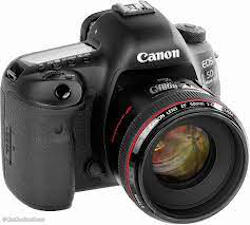
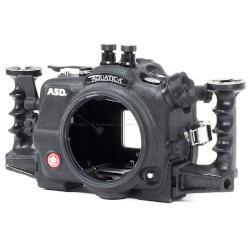

The Canon EOS 5D series is one of the most recognized camera lines of the digital age and the Mark IV is designed to appeal to a wide range of professionals. Nearly identical in appearance to its predecessor, it features considerable upgrades, including: a higher-resolution sensor with Dual Pixel auto-focus, 4K video capture, an upgraded AF system, improved weather-sealing, built-in Wi-Fi/NFC, an interval timer and GPS. All this adds up to an amazing camera that fits into Canon's product line.
The 5D Mark IV is Canon's first full frame camera that can continuously focus in Live View during stills capture, and because of the way Dual Pixel AF works, focus is generally very accurate. It's good at sticking to the original subject on which you initiated the focus, and it's easy to specify the subject by tapping on it on the touchscreen in 'Face Detect+Tracking' mode.
Underwater and even in poor visibility, the camera will easily snap autofocus. And, if the camera is tilted from a near subject to a far subject, the focus triggers quickly and smoothly. The new autofocus features in this camera could be a milestone in video autofocus for underwater photographers.
No other DSLR camera on the market can master natural light white balances underwater without a color correction filter like this camera. This allows the shooter to take lights in the water and have the option to do natural or artificial light shooting on the same dive. The white balance procedure is a little bit different compared to previous models. This camera does not allow photos in video mode. This requires an additional step to switch to photo mode, take a shot, then go back to video mode. This is not big deal, but if you were used to the procedure on a previous Canon, it’s an additional step.
Canon has made some vast image quality improvements over the previous EOS 5D. Still images are superb and as far as video quality, Canon is the king. For the underwater housing, we recommend the Aquatica or the premium Isotta housing.
Pros
- Improved dynamic range
- True live autofocus in video mode
- Now shooting 4K 30p
- High 500mbps data rate
- 4:2:2 color space
- 1.64 crop in 4K movie mode
Cons
- No zebra or focus peaking in-camera, but available on external monitors
- Large file sizes for 4K video
- Fastest CF card on the market required to ensure uninterrupted video